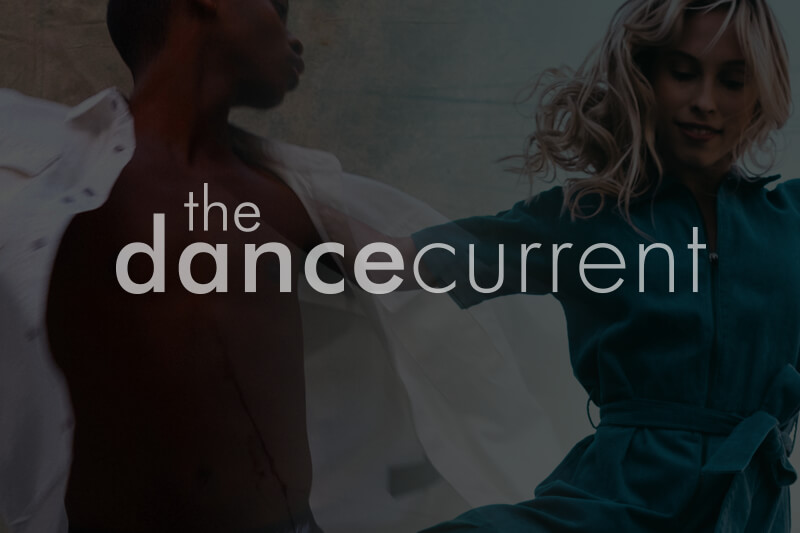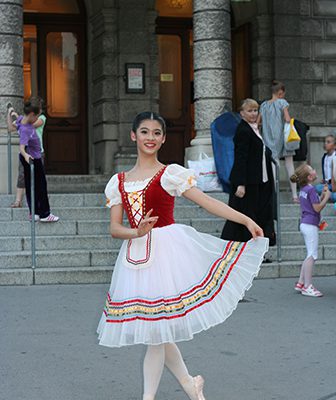For ten days in early June Toronto goes crazy for culture; sort of. That’s when Luminato, the city’s much-vaunted, robustly sponsored “festival of arts and creativity” (speedily launched in 2007), saturates the scene with a multi-disciplinary cornucopia of offerings aimed at boosting the cultural image of Toronto’s as a “world-class” city.
From the start, dance has been a component of Luminato programming. In 2007, the festival was able to piggyback on a project already in the works from Mirvish Productions to offer Lizt Alfonso’s Havana-based Danza Cuba in the premiere of a quasi-musical with lots of dancing called “Vida!” Luminato also collaborated with Harbourfront Centre to present the local debut of the estimable Shen Wei Dance Arts from New York.
In 2008, having secured the University of Toronto, Faculty of Music’s somewhat amenity-challenged yet dance-friendly 800-seat MacMillan Theatre, Luminato was able to present the much-acclaimed Mark Morris Dance Group (MMDG) in two delightful programs. Morris’s troupe had made its Toronto debut at Harbourfront Centre’s (then) Premiere Dance Theatre in 1992 but it took Luminato to bring it back and put MMDG in a venue large enough to do it full justice – a deep stage and an orchestra pit for live music.
In planning the 2008 festival, Luminato had also been eyeing Alberta Ballet and its new Joni Mitchell song-fuelled work, “The Fiddle and the Drum”. There was talk of bringing it to the Elgin Theatre but in the end the National Ballet of Canada (NBoC) rearranged its own season, postponed the previously announced North American debut of Canadian choreographer Dominique Dumais’ “Skin Divers” and agreed to present Alberta Ballet in its own mixed bill at the Four Seasons Centre opera house.
By way of context, it’s important to understand why the unusual arrangement occurred. Luminato is a problem for the National Ballet and the National Ballet is a problem for Luminato.
When NBoC hammered out its tenancy agreement with the Canadian Opera Company (COC), owners of the new opera house, it had little negotiating leverage and was forced by COC honchos to accept two weeks in the late spring. Under the best of circumstances – i.e. no strong competition – June is not an easy time to lure people into a theatre. In its former venue – the longtime O’Keefe, then Hummingbird, now Sony Centre – NBoC had normally closed its season by mid-May. Then, more quickly than anyone imagined possible, just as NBoC moved into the Four Seasons Centre, Luminato exploded onto the scene with a schedule overlapping NBoC’s. NBoC artistic director Karen Kain, with all the credibility, respect and glamour she commands, had been shamelessly deployed by Luminato as a shill in the run-up to the inaugural festival. Yet, when the programming was announced, Kain’s company was left out in the cold. Once Luminato’s marketing got into full gear NBoC’s sales dried up.
Even being under the Luminato umbrella — by virtue of including the Albertans and their “Fiddle” in 2008 – did not significantly bolster NBoC’s sales, any more than it did this June when the company again managed to be included in the Luminato brochure by dint of presenting the North American premiere of a “Carmen” ballet by Italian choreographer Davide Bambine — on a double bill with Dumais’ postponed “Skin Divers”.
The folk at Luminato, one can reasonably surmise, would love to have use of such a prestige venue as The Four Seasons Centre because it would open up the possibility of programming a really big foreign ballet or opera company. For the foreseeable future, however, since NBoC cannot shift its season, Luminato is effectively shut out of Toronto’s much-lauded opera house and NBoC is obliged to compete for audience with the festival.
Dance loving audiences, of course, don’t care much about this backroom stuff and from their perspective the 2009 Luminato had lots to offer, including an unprecedented quantity of Canadian choreography.
There was Sandra Laronde’s Red Sky Performance in the local premiere of “Tono”, a cross-cultural exploration of themes of “shamanism and the majesty of the horse”, the aforementioned arrival of Dumais’ “Skin Divers” and, as part of the Toronto debut of the celebrated Nederlands Dans Theatre (NDT), the North American premiere of Crystal Pite’s “The Second Person”.
Red Sky Performance: “Tono”
Fleck Dance Theatre, Harbourfront Centre, Toronto June 5-7, 2009
A “tono”, so I’ve read, is the name for a circular opening at the apex of a tent, the kind commonly found among nomadic peoples. Thus the title of Red Sky’s most recent production, developed more than a year ago at the Banff Centre and already performed there and in Beijing, aptly captures the work’s theme of shared cultural experience. It also partly makes sense of a dominant element in designer Julia Tribe’s set – a suspended circular object that structurally resembles a wagon wheel shaped into a dome.
“Tono”, according to Laronde, emerged from first-hand experience of Mongolian culture during her travels in Asia. Laronde’s perception of links between that culture and the experience and beliefs of Canada’s indigenous peoples, particularly where horses and shamanism are concerned, was the foundation upon which “Tono” was built. Unfortunately, the finished fifty-five-minute work – despite the worthiest of intentions, many appealing and beautiful episodes and strong performances by dancers and musicians alike – is ultimately incoherent. Epic in ambition, it never achieves the moment of catharsis to which it seems to aspire.
“Tono”, which will continue to tour, brings together artists from Asia and Canada, three male and three female dancers and five musicians – vocalists and instrumentalists – in a cross-cultural evocation of the power and beauty of the horse and a less successful thematic thread of spirituality and shamanism.
The choreography, credited to Laronde and Montréal-based Roger Sinha, presents the pony-tailed dancers variously as horsemen and horses. They trot and gambol and gallop. Sometimes, as in a stunning stampede-like ensemble, the horses run free. Other times they are tamed – a grappling male duet for that – yet still retain an aura of nobility. There are heroic, leaping, spinning male solos and two of the women, skilled contortionists, shape their bodies into stunning sculptural images. Then there’s the birthing section.
Towards the end of “Tono” two of the men drag in a large white cloth bundle. The material is stretchy and it’s no surprise – for anyone old enough to remember the work of Alwin Nikolais – when its contents begin to move and contort the bundle into a series of curious shapes. It becomes apparent that there are two bodies inside and the notion that we are perhaps observing the birth of twins is confirmed when one breaks free; the other never makes it, thus bringing “Tono” to a rather mournful close.
This incongruous closing segment underlines the unfortunate determination to pack too many ideas into a single theatrical package, leaving one much better able to admire the parts than the whole.
Those parts also crucially include Tribe’s attractive costumes and decors and a lovely lighting plot from Kimberly Purtell. The excellent musicianship of three, traditionally costumed Mongolians, is cleverly integrated by composer/arranger Rick Sacks into a part live/part recorded score that spans everything from throat singing to horse sounds.
National Ballet of Canada: “Skin Divers” and “Carmen”
Four Seasons Centre for the Performing Arts, Toronto June 6-14, 2009
A similar sum-of-the-parts problem afflicts Dominique Dumais’ “Skin Divers”, although in her case it’s not so much an issue of clarity and cohesion as it is a head-on collision between competing elements.
The ballet, originally made for a Berlin company in 2003, is inspired by two of Canadian writer Anne Michaels’ poems, “Skin Divers” and “Last Night’s Moon”. These are rich, sensuous, image-laden poems wrapped in a skein of memory and sweet melancholy. They’re the kind you want to savour slowly, quietly, privately. Although Michaels’ poems were printed in the house program, Dumais opted to record Michaels reading them at a languorous pace and combined the result with Gavin Bryars’ “String Quartet No. 2” – played live – and an intimate, roving video by Tatyana van Walsum of a naked woman, initially projected onto a huge front scrim and later onto a smaller curtain of narrow translucent strips.
Dumais’ interest is in exploring the idea of the body as an organic store of experience, thus pitching the physical action of the ballet into a shadowy, evanescent quasi-dream world, dimly revealed by Mark Stanley’s lighting and often effectively evoked by Bryars’ score.
Choreographically it’s a mixed bag of movement for four couples, deployed as such as well as in a variety of solos and ensemble combinations. Angular movement, upper/lower body isolations and deep pliés in second abound. There are also curious, almost acrobatic motifs and athletically convoluted partnering.
The problem is that it’s hard to absorb the choreography because the various elements that make up the ballet compete for attention. The first section of Van Walsum’s beguiling video is intended to convey the notion of diving beneath the skin into a world of memory evoked by the choreography; except it’s hard to concentrate on the movement when you’re trying to listen to Michaels – a languid, deep-throated read – and to Bryars’ mesmerizing score and all the while attempting to process them mentally so they all fit together.
It’s a little easier when the front scrim is flown out and we get a better view of the dancing. The passage of dancers back and forth through the panels of the smaller curtain nicely evokes the idea of fleeting recollection, but less so when the curtain becomes the screen for a video close-up of pubic hair.
Most theatrical dance mixes media and is by nature multi-disciplinary. Choreographers were integrating spoken text and projected imagery into their work long before Dumais was born. The issue is how many media can you throw into the mix before one starts cancelling out another?
Perhaps Dumais’ hope is that her audiences, rather than trying to focus, will slip into a trance-like state in which the recited poetry, movement, music and video will somehow blend and communicate subliminally. Who knows, perhaps it does work for some people like this. Yet, when poetry, music and video are each so engrossing it’s really hard to divide one’s attention.
Not surprisingly, “Skin Divers” elicited only polite applause. Unlike the torrid Davide Bambine “Carmen” that followed – uppercase choreography throughout – Dumais’ ballet is not engineered to solicit an ovation.
Nederlands Dans Theater: “Shoot the Moon”, “Wings of Wax” and “The Second Person”
MacMillan Theatre, University of Toronto June 11-13, 2009
Even if it was only for three performances, the long-awaited Toronto debut of Nederlands Dans Theater was a Luminato highlight. Within the triple bill, NDT brought Canadian choreographer Crystal Pite’s “The Second Person” which, if not the most digestible, was arguably the meatiest offering on view.
Pite’s two-year-old, large-cast ballet sees her working with themes and ideas that have preoccupied her before and since. Thematically Pite is fascinated by the tug between human individuality and social conformity, a concern that translates well into movement since it offers a valid pretext for arresting solos and theatrically impressive, unison or contrapuntal ensembles.
Where “Emergence”, Pite’s recent work for the National Ballet, carries her theme into a subterranean insect nest apparently dominated by predatory females, “The Second Person”, from 2007, is closer to the Kafkaesque world of urban alienation so stunningly evoked by the late Jean-Pierre Perreault in his 1983 masterwork, “Joe”.
Pite, of course, has her own very individual take on this modern yet well-worn theme, cleverly utilizing stick puppets as a potent metaphor. We hear a self-written text, through the recorded and almost chillingly dispassionate voice of Kate Strong. “This is a picture of you falling.” “Here you are a little later.” “This is the sound of your heart hitting the floor.” “This is a picture of you remembering something as a young man.”
The voiceover is archly layered, speaking both to a large theme of suppressed individuality and to the fact that the dancers are themselves required to follow choreographic direction. Yet the same “now you do this” choreography includes representations of attempted breakouts where particular individuals are, so it appears, no longer manipulated – as the puppets symbolically are – but have brief opportunities to assert their first-person authenticity.
Pite nevertheless does not offer us much hope beyond these momentary excursions. Even the duets are fraught. Her own décor is a stormy sky and hazy city skyline. Longtime Pite collaborator Owen Belton’s score alternates between oppressive and lyrical; urban-industrial with plaintive strains of folk songs. Pite’s closing image – at the end of an overly long forty-five minutes – is a human puppet, a woman virtually stripped naked and manipulated onto the stage by the other cast members like a life-sized version of the wooden stick puppet we’ve seen earlier.
“The Second Person” packs quite a wallop. And it hardly needs saying that its twenty-five-member cast danced it superbly; but then NDT dances everything superbly. It’s one of a kind.
Tagged: Ballet, Contemporary, Indigenous, Performance, ON , Toronto





